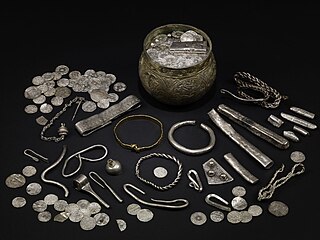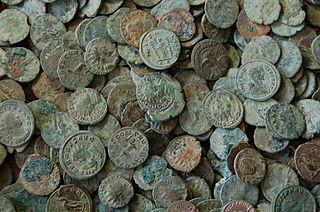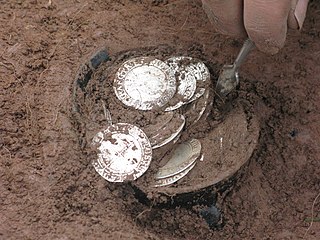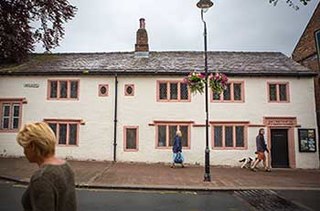Related Research Articles


Padbury is a village and civil parish in north Buckinghamshire, England. It is located on the A413 main road that links Buckingham with Winslow.

The Treasure Act 1996 is a UK Act of Parliament, defining which objects are classified as treasure, legally obliging the finder to report their find.

The Vale of York Hoard, also known as the Harrogate Hoard and the Vale of York Viking Hoard, is a 10th-century Viking hoard of 617 silver coins and 65 other items. It was found undisturbed in 2007 near the town of Harrogate in North Yorkshire, England. The hoard was the largest Viking one discovered in Britain since 1840, when the Cuerdale hoard was found in Lancashire, though the Anglo-Saxon Staffordshire Hoard, found in 2009, is larger.

The Staffordshire Hoard is the largest hoard of Anglo-Saxon gold and silver metalwork yet found. It consists of almost 4,600 items and metal fragments, amounting to a total of 5.1 kg (11 lb) of gold, 1.4 kg (3 lb) of silver and some 3,500 pieces of garnet cloisonné jewellery. It is described by the historian Cat Jarman as "possibly the finest collection of early medieval artefacts ever discovered".


The Frome Hoard is a hoard of 52,503 Roman coins found in April 2010 by metal detectorist Dave Crisp near Frome in Somerset, England. The coins were contained in a ceramic pot 45 cm (18 in) in diameter, and date from AD 253 to 305. Most of the coins are made from debased silver or bronze. The hoard is one of the largest ever found in Britain, and is also important as it contains the largest group ever found of coins issued during the reign of Carausius, who ruled Britain independently from 286 to 293 and was the first Roman Emperor to strike coins in Britain. The Museum of Somerset in Taunton, using a grant from the National Heritage Memorial Fund (NHMF), acquired the hoard in 2011 for a value of £320,250.


The Bredon Hill Hoard is a hoard of 3,784 debased silver Roman coins discovered in June 2011 by two metal detectorists on Bredon Hill in Worcestershire, approximately 400 metres north of Kemerton Camp, an Iron Age hill fort. The coins were found in a clay pot that had been buried around the middle of the 4th century in a Roman villa, identified by the subsequent archaeological excavation. The coins include the reigns of sixteen different emperors during the mid to late 3rd century, and are the largest hoard of Roman coins to have been discovered in Worcestershire to date.


The Bitterley Hoard is the largest post medieval / English Civil War Coin Hoard found to date from Shropshire, England. It was discovered on 17 February 2011 by a metal detector user near the village of Bitterley, South Shropshire. The find consists of one gold coin and 137 high denomination silver coins. These were placed within a high quality leather purse which was contained within a pottery vessel called a tyg. The earliest coin was from the reign of Edward VI, the latest from the Bristol Provincial Mint of Charles I, indicating it was buried after early 1644.
The year 2014 in archaeology involved some significant events.

Viking coinage was used during the Viking Age of northern Europe. Prior to the usage and minting of coins, the Viking economy was predominantly a bullion economy, where the weight and size of a particular metal is used as a method of evaluating value, as opposed to the value being determined by the specific type of coin. By the ninth century, the Viking raids brought them into contact with cultures well familiarised with the use of coins in economies of Europe, hence influencing the Vikings own production of coins.

Penrith and Eden Museum is a museum in Penrith, Cumbria, England. The museum aims to collect, preserve and display material reflecting the history and culture of Penrith and Eden. The museum is owned and managed by Eden District Council. The museum is based in a former school building, known as Robinson's School, which first opened in 1670.
Philippa Mary Pearce is a senior conservator at the British Museum. She is particularly known for her work on coin hoards found in England and was awarded an MBE for services to metal conservation in 2018. She has worked on most of the coin hoards found in recent years as part of the Treasure process.
The Herefordshire Hoard is a hoard of coins and jewellery dating to the Viking period found near Leominster, Herefordshire in June 2015.
References
- 1 2 Smith, Lewis (2 January 2015). "£1m Anglo-Saxon silver haul dug up on Buckinghamshire farmland". The Independent. Retrieved 2 January 2015.
- 1 2 "Thousands of ancient coins discovered in Buckinghamshire field". BBC News. 2 January 2015. Retrieved 2 January 2015.
- 1 2 Lovett, Lorcan (2 January 2014). "Metal detector fan unearths 5,000 Anglo-Saxon coins in Buckinghamshire field". Getbucks. Archived from the original on 3 January 2015. Retrieved 2 January 2014.
- ↑ Lenborough Hoard bucksas.org.uk 2015 Retrieved 17 May 2023
- 1 2 "Silver coins worth £1m found on farm". Buckinghamshire Advertiser & Review. 31 December 2014. Retrieved 2 January 2014.
- ↑ "Largest Anglo-Saxon coin hoard tops list of latest nationwide treasure finds". Portable Antiquities Scheme. 10 February 2015. Retrieved 11 February 2015.
- ↑ "Advice for museums on funding Treasure acquisitions". Portable Antiquities Scheme . Retrieved 3 January 2015.
- ↑ "Lenborough Anglo Saxon coin hoard valued at £1.35m". BBC News. 7 June 2016. Retrieved 1 May 2021.
- ↑ "Lenborough Hoard". Discover Bucks. Discover Bucks. nd. Retrieved 8 March 2023.